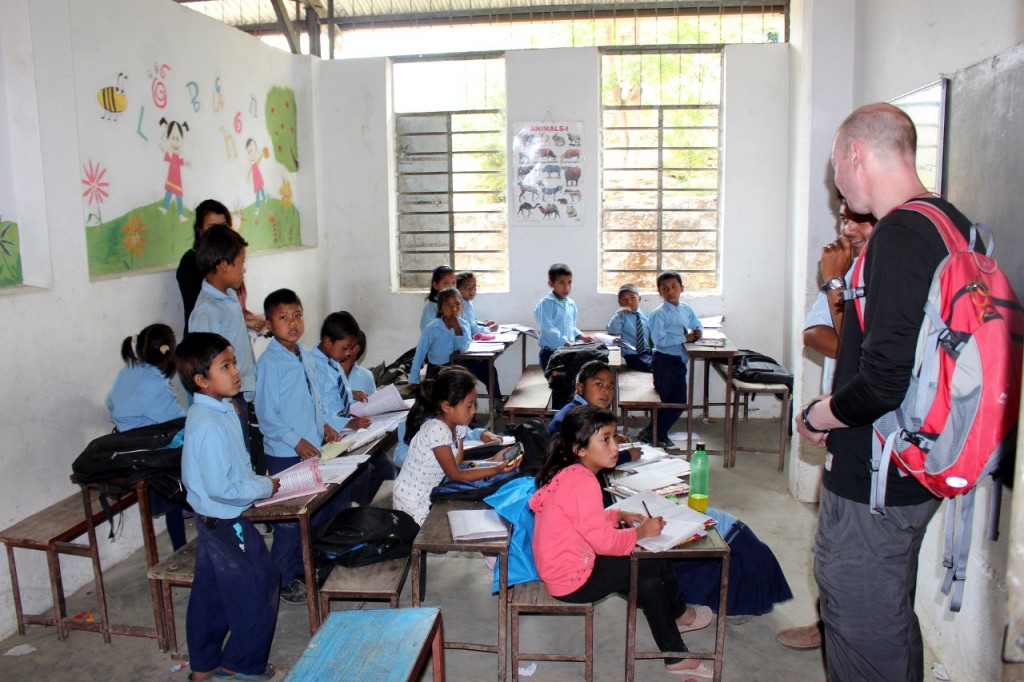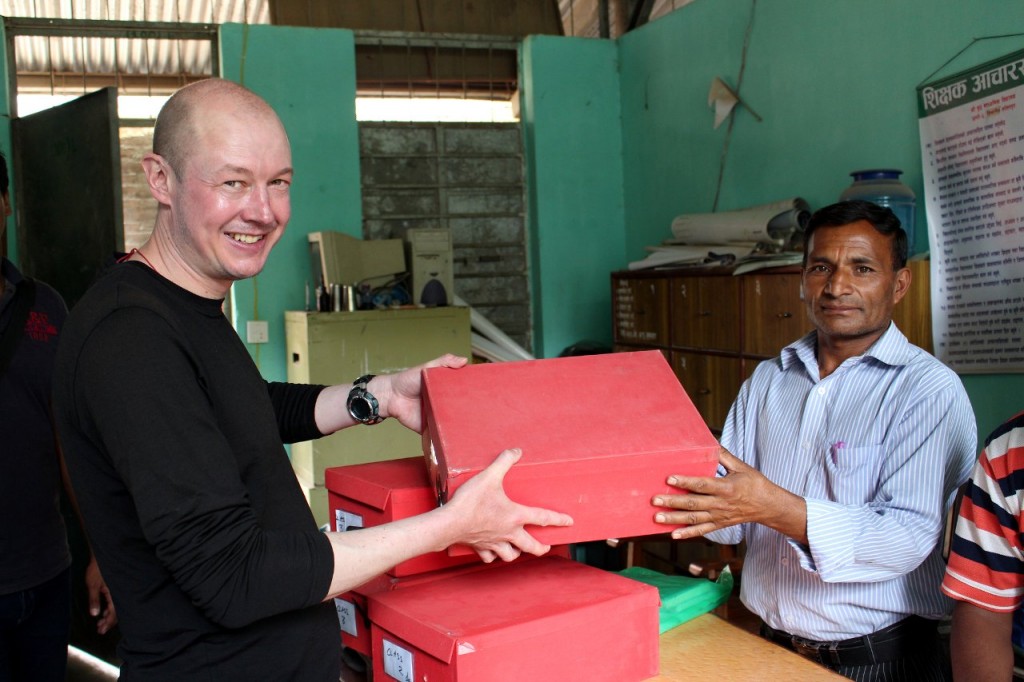One consequence of the Everest season ending early and all expeditions returning home is that I’ve spent an unusually long time in Kathmandu while I wait for my flight back home, catching up with things and contemplating a surreal season. I’ve even managed to salvage some good from three weeks of tragedy and conflict which have dashed the hopes and dreams of westerners and trashed the reputation of the industrious Sherpa people.
Three weeks ago, on April 18, I watched a huge avalanche, one of the biggest I have ever seen, tumble down the Khumbu Icefall and kill 16 people. I heard first hand accounts of the horrific injuries, mostly from exploding ice like shrapnel. I watched bodies hauled by helicopter on long lines. I heard the whispers of an atmosphere of intimidation building up at base camp. I witnessed puja (blessing) ceremonies for the dead turned into political rallies, I watched militant agitators turn Sherpa against westerner in public gatherings, and I returned to Kathmandu in sorrow, disappointment and disgust. Like most other climbers I logged onto the net and read my hate mail telling me how I’m a rich spoilt brat who murders Sherpas (my team mate Robert Kay says most of these are from middle aged men sitting in their mothers’ basements clad in just their underpants). Most of us were besieged by journalists when we returned to civilisation, keen to tailor our words into soundbites to suit whatever story they were writing. But I prefer to speak for myself; I declined all interviews and kept quiet. I have much more to say about all of these things, but this post is about the good I’ve been able to salvage from a month of loss.

We arrived back in Kathmandu on April 26. Our bags are yet to follow us; they are currently still at Lukla Airport awaiting a flight out. Many climbers were stuck there for days too, as the weather remained angry. Lodges in the tiny little village perched above the Dudh Khosi Valley started running out of food. People were weeping in the streets, and many chose to trek out for five days rather than wait for a flight. They say a Sherpa was struck by lightning and killed, and here in Kathmandu it’s been sheeting down every day like the monsoon has already started. The mountain gods really weren’t happy this year.
Some people will tell you I spend nearly all my time in Kathmandu sitting around in bars. There’s some truth in this, and there are a few places in Thamel I can walk into and I don’t have to say anything; they already know what I’m drinking. But I’ve been here nearly two weeks now, and I’ve also been taking the opportunity to do some charity work.
For the last two years I’ve been trustee of a UK charity, CHANCE, who provide aid for various education projects in Nepal. One of my responsibilities as trustee is to ensure donations are being spent effectively and efficiently. This isn’t always easy when you’re based remotely in London, having Skype meetings with staff in Nepal and reading documents. It’s really useful to get out into Nepal and find out what things look like in the field.
CHANCE’s work falls broadly into three categories: a legacy programme of voluntary work by UK volunteers on vocation who sponsor individual children through school; a child-friendly teacher training programme in 64 schools; and our flagship programme as National Award Operator for the Duke of Edinburgh’s International Award in Nepal. As many of you will know, the Duke of Edinburgh’s Award is a scheme to get young people outdoors and teach them skills outside the ordinary academic school curriculum.
I visited Shree Buddha School in the Kathmandu Valley, a government school with around 400 pupils crowded into an area not much larger than a tennis court. Despite having 10 classes, the government only provides funding for 8 teachers, so the school management must find the money to pay the additional 3 teachers on their staff through private funding. Some classes have as many as 50 pupils, desks are small, and there is barely enough elbow room to write. CHANCE volunteers from Glasgow University helped to build a classroom extension during a homestay and exchange visit, and we’ve provided additional help with teaching aids, toilets and a water tank. But there’s still lots to do here: the shool badly needs additional classroom space, a proper playground for the children and a sustainable income to fund extra teachers.

A few days later I visited a school that couldn’t be more different: Rato Bangala, one of Nepal’s top private schools. Here 800 pupils occupy modern six storey buildings in spacious grounds. Class sizes are no more than 30, each with two teachers supervising. The school has its own teacher training college, which means it has access to as many as 100 teachers and trainee teachers at any one time. This school doesn’t need our help, but there’s plenty it can do for us. School Principal Milan Dixit is Vice Chair of the governing body CHANCE has set up to roll out the Duke of Edinburgh’s International Award to schools across Nepal. Some of her students, who receive a better standard of education than most Nepalis, have been providing tutoring to students in less privileged government schools as part of the community service section of the Award. With her help we hope to deliver the Award to as many as 500 schools in the remote Dailekh district in western Nepal.
I got to meet some other interesting people too. Niraj Karki is Nepal’s national rock climbing champion, who runs the Asian Trekking climbing wall in Thamel. Many Duke of Edinburgh Award students have been choosing rock climbing as their skill, and coming to his climbing wall for instruction. He explained to me how he would like to establish a few outdoor climbing centres in a country that certainly isn’t lacking in big walls.
“Have you ever tried Everest?” he said to me as we sat drinking in a restaurant.
“Why yes, I climbed it from the north side in 2012,” I replied.
“No, no, no. I mean Everest Beer,” he said.
Well, perhaps I’ve had a few too many of those as well, but still I hope to have many more. It’s been a disastrous season that will put many people off coming here for a few years, but whatever may have happened at Everest Base Camp I’m not finished with Nepal yet.
And although I didn’t manage to climb Lhotse – I didn’t even start to climb it – you can still sponsor me if you’re kind enough, and provide funds for CHANCE’s programmes in Nepal (and a big thank you to all of you who have donated so far).







Hi Mark, this was a most enjoyable read as I have taught in similar schools in Asia and also made my own little charitable pilgrimage to Nepal. On my last visit I utilized my baggage allowance (and a bit more besides) to take a big box of toys and goodies to an orphanage on the outskirts of Kathmandu. No one there spoke much English so the visit was short and sweet, but there were plenty of smiles and appreciative nods. When you visit these places you realize that your contribution is just a drop in the ocean compared with what could be done to help these kids. Hats off to you Mark for making a few dreams come true, especially in the light of recent sad events.